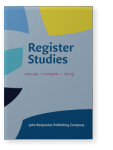Vol. 1:1 (2019) ► pp.136–167
Register in historical linguistics
Merja Kytö is Professor of English Language at Uppsala University. In this article, she provides a detailed accounting of the role of register in research on the historical development of language. Her substantial body of work has focused on both the historical development of specific registers, as well as how historical change has been mediated by register. Her research has encompassed a range of time periods (from Early Modern English to the 19th century) and registers (for example, depositions, Salem witchcraft records, and dialogues). Her many edited collections have brought historical linguists together into comprehensive and rigorous volumes, including the Cambridge Handbook of English Historical Linguistics (Kytö & Pahta 2016, Cambridge University Press), English in Transition: Corpus-Based Studies in Linguistic Variation and Genre Styles (Rissanen, Kytö, & Heikkonen 1997, De Gruyter), and Developments in English: Expanding Electronic Evidence (Taavitsainen, Kytö, Claridge, & Smith 2014, Cambridge University Press). She has been a key contributor to the development of principled historical corpora, such as the Helsinki Corpus of English Texts project, which represents a range of registers from Old and Middle English to Early Modern English. Merja Kytö has long been a leader in demonstrating how systematic attention to register can result in rich profiles of historical development, and in addressing the inherent challenges involved in utilizing historical documents for linguistic research.
Article outline
- 1.How is register conceptualized in historical linguistics?
- 2.How does register relate to the research goals within historical linguistics?
- 3.What are the major methodological approaches that are used to analyze or account for register in historical linguistics?
- 4.What does a typical register study look like in historical linguistics?
- 5.What are the most promising areas of future register research in historical linguistics?
-
Corpora and other electronic resources -
References
This article is currently available as a sample article.
References
Corpora and other electronic resources
ARCHER, see A Representative Corpus of Historical English Registers
B-Brown-1931 Corpus
BLOB-1931 Corpus
British National Corpus (BNC)
British National Corpus 2014 (BNC2014)
Brown Corpus (The Standard Corpus of Present-Day Edited American English)
Cambridge International Corpus
Corpus of Early English Correspondence (CEEC)
Corpus of Early English Medical Writing (CEEM)
Corpus of Early Ontario English (CONTE)
A Corpus of English Dialogues 1560–1760 (CED)
Corpus of Historical American English (COHA)
Corpus of Late Modern English Texts Extended Version (CLMETEV)
A Corpus of Nineteenth-century English (CONCE)
Corpus of Oz Early English (COOEE)
Early English Books Online (EEBO)
Google Books
Helsinki Corpus (Helsinki Corpus of English Texts)
International Corpus of English Great Britain (ICE-GB)
Lancaster-Oslo/Bergen Corpus (LOB)
Literature Online (LION)
Old Bailey Corpus (OBC)
A Representative Corpus of Historical English Registers (ARCHER)
Spoken BNC2014
Zurich Newspaper English (ZEN)
Cited by
Cited by 8 other publications
This list is based on CrossRef data as of 13 april 2024. Please note that it may not be complete. Sources presented here have been supplied by the respective publishers. Any errors therein should be reported to them.
